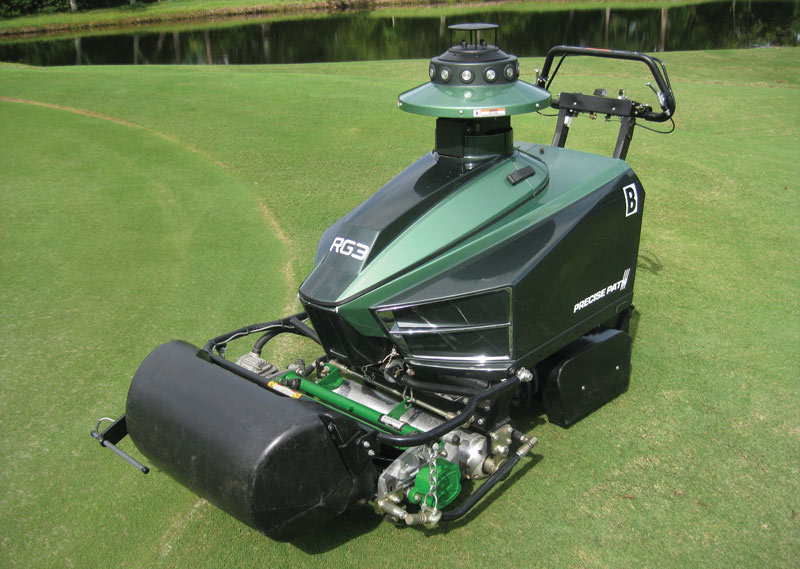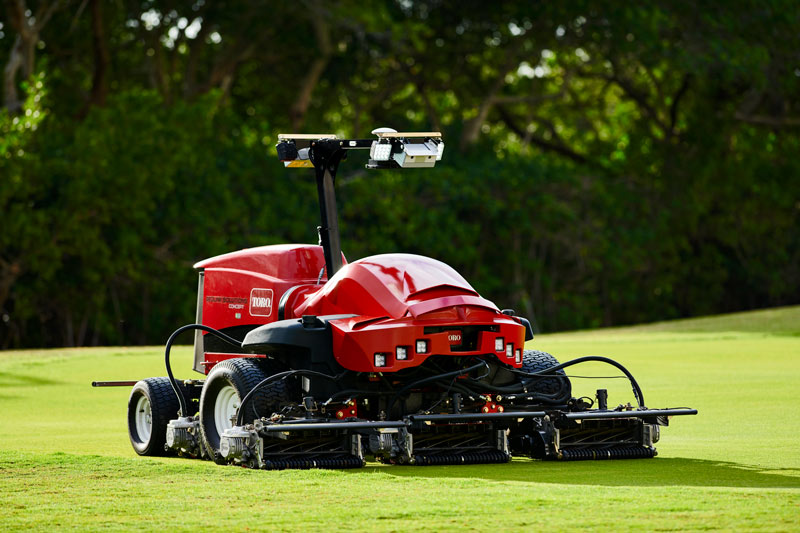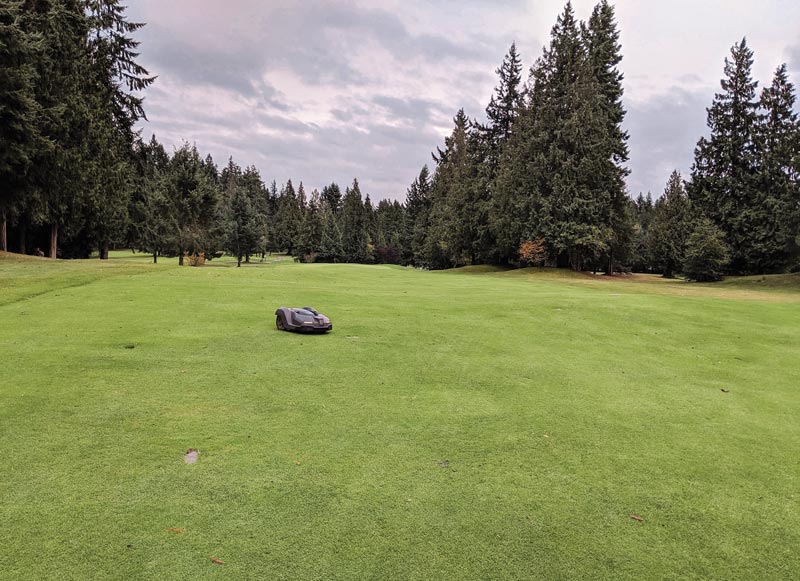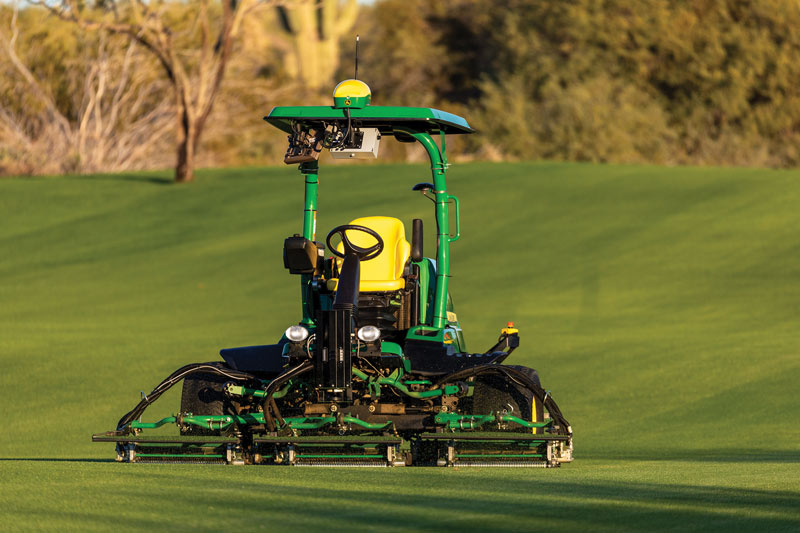
At WINSTONgolf in the German town of Gneven, head greenkeeper Erwan Le Cocq relies on a host of robotic mowers, including a Turflynx fully electric autonomous fairway mower. Photo courtesy of Erwan Le Cocq
Owen Coulson needed to be convinced.
The GCSAA Class A superintendent at Vestavia Country Club in Birmingham, Ala., Coulson had autonomous greens mowers on the brain when he arrived at the 2020 Golf Industry Show in Orlando, Fla., back in January, even though he still had plenty of questions about the emerging technology. “I can’t say I was ready to pull the trigger,” Coulson says.
It took less than an hour for Coulson to be convinced. He listened intently to GCSAA Class A superintendent Justin Daigle from Perry Park Country Club in Larkspur, Colo., whose presentation at GIS on the impact of Cub Cadet’s RG3 autonomous greens mowers at his course transformed Coulson from skeptic to believer. “What he said pretty much answered every question I had about the mower, relieved the anxiety and the fear of putting it on my greens,” says Coulson, a 21-year GCSAA member.
Coulson joined a group of others in his profession who saw the promise of autonomous greens mowing and how it could be an industry game changer. Among those already sold were John Shaw, CGCS, of Valley Brook Country Club in McMurray, Pa. “No drop marks. No gouges on the collar. At my golf course, they cut straight lines. The end product was perfection,” Shaw says. “We may never see greens like that again.”
The exploration of autonomous products for golf began several decades ago. The ongoing effort to provide autonomous equipment should inspire those who crave the possibilities — even after Cub Cadet scuttled its autonomous mower program in mid-February.
The company’s decision to suspend work on its RGX autonomous greens mower — the updated version of the RG3, which was expected to be available later this year and was on display at GIS in Orlando — blindsided many in the industry, and can make one think that Shaw may be right about never seeing something like it in the future.
Tony Whelan, Cub Cadet’s director of sales and marketing, cited technical issues as the reason the RGX was shelved. He stressed that Cub Cadet would not distribute a product that didn’t meet customers’ expectations and needs, and added that the company’s future in autonomous greens mowers was on “indefinite hold.”
That doesn’t mean progress in autonomous equipment in golf has ground to a halt, however. Heavyweights Toro and John Deere are both deep into development of autonomous offerings. Husqvarna and Turflynx have released autonomous fairway mowers that are being used in Canada and Europe. The hope for all of them is to give a boost to superintendents and facilities that face labor challenges and budget constraints.
“In a tight labor market, it makes all the sense in the world to automate as much as possible,” says Brian Nettz, CGCS, a 24-year GCSAA member at the Presidio Golf Course in San Francisco. “It adds efficiencies you really can’t explain until you adapt to an automated system.”
Yet more than a decade after the first autonomous greens mower was rolled out, there is nothing like it right now for superintendents. Daigle, a 20-year GCSAA member, can’t envision a world without the technology. “Autonomous mowers in our industry are not dead,” Daigle says. “It’s our future. It just is.”
A brief timeline of autonomous technology in golf
How did we get here? Eleven years ago, autonomous technology appeared to be on the cusp of a breakthrough in golf course management.
The autonomous greens mower surfaced in 2009 at GIS in New Orleans. It featured a local positioning system that could operate at any time of day and move precisely across greens, maintaining height of cut and traveling in straight lines across curved perimeters without the need for a human operator. After he first saw it, Shaw was among those who recommended that Precise Path, which produced the first autonomous greens mower, make some tweaks, which, by the 2010 Golf Industry Show in San Diego, the company had.
“They were using the back roller of the cutting unit as the main roller that supported the frame for RG3. So, the back roller stayed on the ground and put all its weight on a 2-inch-diameter roller, which would make the cutting head scalp and cause mowing issues,” says Shaw, a 29-year GCSAA member.

The one that started it all: Precise Path’s RG3 autonomous greens mower. Photo by Scott Hollister
In 2011, Precise Path and its RG3 units took another step forward. Hawks Landing Golf Club at the Marriott World Center in Orlando became the first demonstration facility in the world to maintain its greens with autonomous greens mowers. “Once we got dialed in, the greens were pretty slick and looked great,” says Sean O’Brien, CGCS, who at the time was director of grounds at Hawks Landing.
In 2015, Precise Path was acquired by MTD Products, the parent company of Cub Cadet. That year, the first commercially available RG3s rolled off the line.
Now, fast-forward to 2020: When he attended GIS this year, Shaw says he got no indication from Cub Cadet that the decision to halt its autonomous greens mower program was on the horizon. In fact, he had expected to get his hands on the RGX in May, which is why Cub Cadet’s decision stunned Shaw, who had tested RGX units and intended to purchase six of them for a total cost of $400,000.
“For them to walk away from it ... that’s hard to take after watching (the RG3s) work really well at our club,” Shaw says.
Companies continue to invest in autonomy
Although pioneer Cub Cadet is out of autonomous greens mower development — at least for now — that isn’t stopping others from pursuing autonomous products in a big way. John Deere and Toro are both hard at work in this arena.
John Deere established itself in autonomous technology in the agricultural market many years ago. In 2019, John Deere announced that it was in the developmental stages of an autonomous fairway mower and revealed a working prototype during a customer event last July at its primary testing and demonstration site in Coal Valley, Ill. (The mower was also on display in the company’s booth at GIS in Orlando.)
See John Deere’s autonomous fairway mower in action at last summer’s customer event:
Deere’s prototype is outfitted with GPS technology that guides the mower based on fairway mapping and routing set in advance by the superintendent. Sensors on the front and back of the mower detect obstacles that may be encountered while mowing and allow the machine to steer clear.
“The golf industry needs more sustainable operating models to maintain precision turf, so expanding the use of technology will be critical to the future success of the industry,” says Brooks Hastings, product manager for John Deere.
Toro also revealed autonomous possibilities at GIS in Orlando, and work on those products and others continues. In fact, the technology has been on the company’s mind for a long time.
“Dana Lonn, who had been director for Toro’s Center of Turf Technologies for many years, initiated multiple research and development projects over the years for different types of autonomy on turf products. His team tried to find the right recipe to make autonomous products a reality,” says Tony Ferguson, Toro’s senior product marketing manager. “Today, building off of that legacy, we’re seeing a confluence of technologies, market acceptance and price point to make autonomous operations a reality for our market.”
In Orlando, Toro showcased what it’s developing to deliver autonomous capabilities. In addition to a flashy prototype of a fairway mower without a seat or steering wheel (see photo below), the company showed off its GeoLink Solutions initiative, a suite of products designed to offer golf course operators a one-stop shop to manage their autonomous products, which Toro says leads to dependable and repeatable course operations that result in consistent playing conditions.
Toro also introduced both Reelmaster- and Greensmaster-enabled concept mower units. According to Ferguson, the Greensmaster was configured to be autonomous with a number of technologies for guidance, navigation, path planning and obstacle detection. The Reelmaster has additional cameras, sensors and capabilities for autonomous operation. Both products are in the company’s Level 4 category, which means that an attendant is required in the vicinity during operation, but the attendant can be performing other tasks, thereby increasing productivity and saving labor costs.

At the 2020 Golf Industry Show in Orlando, Fla., Toro showed off an autonomous fairway mower sans seat or steering wheel. Photo courtesy of The Toro Co.
“We’ve heard from many superintendents that have said, ‘I’m ready for the technology. I’m ready to incorporate autonomous products into our operations now.’ Others remain skeptical,” Ferguson says. “As you might anticipate, manufacturers need to prove that autonomous products are effective, economical and reliable before some customers will decide to make the investment.”
Neither Toro nor John Deere has set a date for completion of its developmental trials, or for when its products will be commercially available.
Another industry manufacturer, Jacobsen, says some of its mowers can be matched to third-party autonomous solutions currently available in Europe and Japan. Jacobsen views what Cub Cadet started as crucial.
“Early adopters and practitioners are helping us all learn valuable lessons related to autonomy,” says Jacobsen’s Richard Comely, the company’s international director of product management.
Industry veteran Melvin B. Lucas Jr., CGCS Retired and GCSAA president in 1980, says it’s vital for those companies and others to keep their foot on the pedal in the name of autonomous technology.
“No matter what decade, there always has been a cry for good help, quality help, to make things work at a golf course,” the 58-year association member says. “I think these types of autonomous products can have a major impact on the survival of golf courses today. I wish I had them 40 years ago.”
A step ahead in Europe, Canada
Erwan Le Cocq apologized for his late email reply. There was a good reason for his tardiness. A new fleet of autonomous fairway mowers had been keeping him occupied at the facility in Germany that he manages as head greenkeeper.
Autonomous equipment has made inroads in Europe and in Canada, and Le Cocq is among those who have bought in to the technology. He has 23 Husqvarna autonomous fairway mowers in his arsenal at WINSTONgolf in the town of Gneven, in addition to a Belrobotics Bigmow — which the company says is recommended for driving ranges, sports pitches, public spaces and private estates — and a Turflynx fully electric autonomous fairway mower.
“It (Turflynx mower) is very important. It relieves us from the stress of having a hydraulic leak, it saves a lot on fuel cost, and it’s extremely quiet,” says Le Cocq, a one-year member of GCSAA. “I would never have imagined something like this 10 years ago, and now, I would never imagine having to do without it.”
Le Cocq says he had planned to order a full fleet of Cub Cadet’s autonomous greens mowers. Even without them, he foresees autonomous products as a force. “I think they’ll be the norm quicker than people think. Labor shortages, budget reductions and technology advancements will force superintendents to make the move,” Le Cocq says.
One European industry observer thinks autonomous products have a long way to go, but doesn’t minimize the implications if such products blossom. “It’s (autonomous mowing) still a little like electric vehicles — it’s still in the early days,” says Scott MacCallum, editor of Turf Matters, a magazine that covers the golf course management and sports turf industries in the United Kingdom and Europe. “The technology is improving, but it isn’t completely there yet for golf, particularly in the U.K. But it could free up a lot of labor if they get things to go well.”

Jason Haines, superintendent at Sunshine Coast Golf & Country Club in Roberts Creek, British Columbia, employs a Husqvarna Automower in his fleet and has plans to add several more. Photo courtesy of Jason Haines
So far, mostly so good for one Canadian GCSAA member. Jason Haines, superintendent at Sunshine Coast Golf & Country Club in Roberts Creek, British Columbia, likes his lone Husqvarna Automower, a small autonomous robotic fairway mower. He likes it so much that he hopes to grow his fleet by 60 — but not until the next wave of technology is available. Haines also has an opinion on which autonomous product should have come first, and is convinced that a swarm of small machines such as the one he has is the way to go.
“Maybe greens should be the last place to put a robot,” says Haines, a four-year member of GCSAA. “Greens need to be cut with a lot of precision. You’ve got to have a person there, and it has to be done quickly. Economically, it (an autonomous greens mower) was a non-starter for me. It (Cub Cadet’s RG3) is really cool technology; it just didn’t make financial sense. If it doesn’t make financial sense, hardly anyone will invest.”
The main issue Haines has encountered with his autonomous fairway mower? Perhaps being too reliant on it. “Something may break, and you may not notice it for a few days,” he says. “It went three or four days after a blade fell off. It’s so hands-off, you don’t even notice.”
What’s next for autonomous technology in golf course maintenance?
Cub Cadet remains in never-say-never mode about potentially reviving its autonomous greens mower program. “We’re committed to autonomous innovation,” Whelan says. Until then, Cub Cadet has informed those who have the RG3s that the company will help them with a transition plan, including retrieval of the RG3 units.
Meanwhile, there are other ways to mow greens. Daigle, for instance, says he’ll “never go back to walk-mowing greens,” and is still trying to overcome the disappointment of losing the RG3. He had three years remaining on a five-year lease of his fleet.
“Superintendents are thrown curveballs all the time in our industry,” Daigle says. “This is no different than a significant weather event or a budget or labor situation. We keep our chin up, stay optimistic and continue to produce the best product we can with the means given.”

John Deere’s working prototype for this autonomous fairway unit was on display for customers at its Golf Technology Preview event in July 2019. Photo courtesy of John Deere
Shaw recently purchased three riding triplex greens mowers. “I called many superintendents in Pittsburgh and asked if they hand-cut or ride. To my surprise, most clubs already switched to riding mowers,” he says.
Shaw has advice for any company that plans to design an autonomous greens mower to fill the void left by Cub Cadet. “Make it affordable,” he says.
Precise Path’s entry into the autonomous arena has made this entire conversation possible. Jason Zielke, vice president of international product development for MTD Products, was one of the first members of the Precise Path team when it formed in 2006 (see “How the first robotic greens mower came to be,” below). He is happy the industry seems willing to pursue the technology Precise Path jump-started way back when. “I did find it exciting to see at GIS this year the efforts by Toro and John Deere to show off their autonomous technology,” Zielke says. “I believe the RG3 has driven a long-term shift in the industry toward more advanced technology.”
At his course in Alabama, Coulson imagines he will get another chance at an autonomous greens mower, whether Cub Cadet revives its efforts or somebody else comes along with their version. “I think that’s where our world is going,” Coulson says.
How the first robotic greens mower came to be
Cub Cadet brought the first autonomous greens mower to the marketplace five years ago. The mower’s roots can be traced to, of all places, the Mojave National Preserve in Southern California, which encompasses Death Valley, one of the hottest places in North America. Turns out Mojave was a hot spot for technology too, as an event there spawned the company that would devise the RG3.
A mutual passion for robotics led entrepreneur Scott Jones and technologist Doug Traster to launch Indy Robotics in 2004, and they provided the platform for their new group to participate in the DARPA Grand Challenge (DARPA stands for Defense Advanced Research Projects Agency) in 2005. The event, initiated by the U.S. Department of Defense, was developed to foster innovations in self-driving vehicles that could be applied to military requirements. The Mojave was the test track for the contest, and while Indy Robotics’ Jeep didn’t win, it produced an idea that would eventually reach the golf course management industry.
In December 2006, Precise Path emerged as a spinoff company of Indy Robotics, and at its launch, it had fewer than 10 employees. One of them was Jason Zielke, the company’s first chief operating officer. Precise Path — seeking to implement its technology for an industry with both high labor and high quality requirements — took what it gleaned from golf course superintendents and began developing what would become known as the RG3 (which stands for robotic greens mower, third iteration). It was introduced 11 years ago at the Golf Industry Show.
“The focus into golf came after a rigorous market review of application opportunities in golf mowing, commercial spraying, residential mowing and military logistics,” Zielke says.
Precise Path was acquired by MTD Products in 2015, and that year, the RG3 became commercially available. The Precise Path name was used briefly after the acquisition as a technology brand (“Driven by Precise Path”), but it was retired relatively quickly, as the market began to make the connection to the RG3 name under Cub Cadet, an MTD property. Zielke, now vice president of international product development for MTD Products-EMEA (Europe, Middle East and Africa), says Canongate Golf Group and ValleyCrest (now BrightView) purchased the initial fleet of pilot units.
“Being the first to sell an autonomous greens mower is certainly a source of pride,” Zielke says.
Howard Richman is GCM’s associate editor.